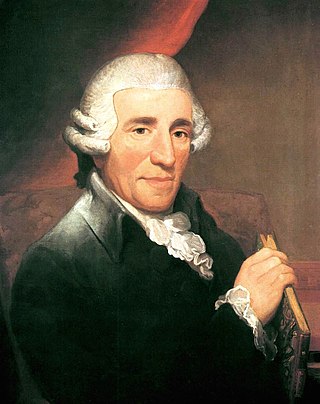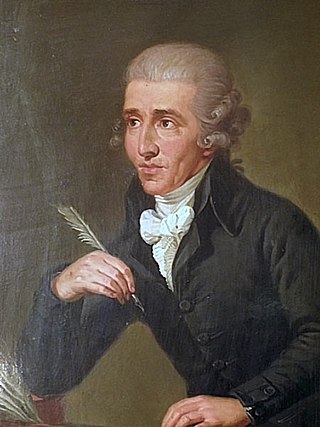
The Symphony No. 7 in C major, Hoboken I/7, is a symphony by Joseph Haydn, sometimes called "Le midi", meaning "The Noon."

The Symphony No. 7 in C major, Hoboken I/7, is a symphony by Joseph Haydn, sometimes called "Le midi", meaning "The Noon."
The symphony was composed in May or June 1761, paired together with the other two of the Day Trilogy, Nos. 6 and 8, and under the patronage of Prince Paul II Anton Esterházy. [1] [2]
It is scored for 2 flutes, 2 oboes, bassoon, 2 horns, strings and continuo, [3] and exhibits many concertante features; indeed, the principal players of each of the string sections have solos, while the winds are given fairly difficult parts. [4] The work is in four movements:
Unlike the sunrise of Le matin, the slow introduction to the opening movement here is a ceremonial march. [5]
The first movement begins with a fanfare style, ten bar passage in C major, followed by the allegro part of the movement in D major. The second andante movement begins with an extended "recitative" in C minor featuring a solo violin, which ends in B minor to give way for the main Adagio section. The Adagio follows in G major with solo violin and solo cello with prominent obbligato flute parts coloring the accompanying orchestration. The movement ends with an extended cadenza for the solo violin and cello. [5]
As is the case with symphonies 6 and 8, the double bass has an extensive solo in the trio of the menuet. Like the previous symphony, the finale contains passages for almost all the instruments, but here it is intensified even more with solos and tuttis often exchanging every other bar. The recapitulation is notably accentuated with horn fanfares. [5]

Joseph Haydn's Symphony No. 13 in D major was written in 1763 for the orchestra of Haydn's patron, Prince Nikolaus Esterházy, in Eisenstadt.

The Cello Concerto No. 1 in C major, Hob. VIIb/1, by Joseph Haydn was composed around 1761-65 for longtime friend Joseph Franz Weigl, then the principal cellist of Prince Nicolaus's Esterházy Orchestra.

The Symphony No. 100 in G major, Hoboken I/100, is the eighth of the twelve London symphonies written by Joseph Haydn and completed in 1793 or 1794. It is popularly known as the Military Symphony.
Symphony No. 93 in D major, Hoboken I/93, one of the twelve London symphonies written by Joseph Haydn.
The Symphony No. 98 in B♭ major, Hoboken I/98, is the sixth of the twelve London symphonies composed by Joseph Haydn. It was completed in 1792 as part of the set of symphonies composed on his first trip to London. It was first performed at the Hanover Square Rooms in London on 2 March 1792. Some musicologists and historians interpret this symphony as Haydn’s tribute to his friend Mozart who had died on 5 December 1791.
Symphony No. 88 in G major was written by Joseph Haydn, for the orchestra of Esterháza under the benevolent Prince Nikolaus Esterhazy. It is notably the first of his symphonies written after the completion of the six Paris symphonies in 1786.
The Symphony No. 97 in C major, Hoboken I/97, is the fifth of the twelve London symphonies written by Joseph Haydn. It was completed in 1792 as part of the set of symphonies composed on his first trip to London. It was first performed at the Hanover Square Rooms in London on 3 or 4 May 1792. First published in England, it made its way to the continent a few years later and was used by Ludwig van Beethoven as a model for a symphony in C major he never completed, and by Friedrich Witt for the Jena Symphony.

The Symphony No. 6 in D major is an early symphony written in 1761 by Joseph Haydn and the first written after Haydn had joined the Esterházy court. It is the first of three that are characterised by unusual virtuoso writing across the orchestral ensemble. It is popularly known as Le matin (Morning).

The Symphony No. 80 in D minor, Hoboken 1/80, is a symphony composed by Joseph Haydn in 1784 as part of a trio of symphonies that also included symphonies 79 and 81. This symphony, along with the one that follows it, and the one that precedes it, were not written for Prince Nikolaus, but for a Lenten concert performed in Vienna in March 1785. It is one of the relatively few later symphonies by Haydn to begin in the minor mode. Symphony No 80 is highly structured with both outer movements in sonata form. There is a common modulation pattern seen in all four movements.
Symphony No. 76 in E♭ major is a symphony by Joseph Haydn completed in 1782.

The Symphony No. 72 in D major is a symphony by Joseph Haydn. The symphony was probably composed between 1763 and 1765. The date of this composition is earlier than its number suggests. This work is not well chronologically placed in the Hoboken numbering system: it was composed fifteen to twenty years before the neighboring works.

The Symphony No. 71 in B flat major, Hoboken I/71, is a symphony by Joseph Haydn. It was composed by 1780.

Symphony No. 67 in F major, Hoboken I/67, is a symphony by Joseph Haydn. It was composed by 1779. The Haydn scholar H. C. Robbins Landon calls this work "one of the most boldly original symphonies of this period."

Joseph Haydn's Symphony No. 31 in D major, Hob. I/31, was composed in 1765 for Haydn's patron Nikolaus Esterházy. It is nicknamed the "Hornsignal Symphony", because it gives a prominent role to an unusually large horn section of four players. Probably because of its prominent obbligato writing for the horns, in Paris, the publisher Sieber published this symphony as a "symphonie concertante" around 1785.

Joseph Haydn wrote his Symphony No. 8 in G major under the employ of Prince Paul II Anton Esterházy in Spring 1761, in the transition between the Baroque and Classical periods. It is the third part of a set of three symphonies that Prince Anton had commissioned him to write – Le matin, Le midi and Le soir. He had given him as inspiration the three times of Day.
The Symphony No. 38 in C major, Hoboken I/38, is an early and festive symphony by Joseph Haydn. The symphony was composed some time between 1765 and 1769. Because of the virtuosic oboe parts in the final two movements, it has been suggested that the work's composition may have coincided with the employ of the oboist Vittorino Colombazzo in the fall of 1768. The symphony is popularly called the Echo Symphony, a nickname that, like all other named Haydn symphonies, did not originate with the composer.

The Symphony No. 30 in C major, Hoboken I/30, is a symphony by Joseph Haydn composed in 1765, at the age of 33. It is nicknamed the Alleluia Symphony because of Haydn's use of a Gregorian Alleluia chant in the opening movement.

Joseph Haydn wrote his Symphony No. 36 in E♭ major, Hoboken 1/36, some time in the first half of the 1760s, around the same time as his Symphony No. 33, for Prince Nikolaus Esterházy. Scored for 2 oboes, bassoon, 2 horns, strings and continuo, the slow movement features solos for violin and cello. It is in four movements:

Joseph Haydn's Symphony No. 15 in D major, Hoboken I/15, may have been written between 1760 and 1763.
Michael Haydn's Serenade in D major, Perger 87, MH 86 was written in Salzburg in 1767.